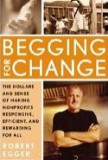Begging for Change: The Dollars and Sense of Making Nonprofits Responsive, Efficient, and Rewarding for All

|
Title | Begging for Change: The Dollars and Sense of Making Nonprofits Responsive, Efficient, and Rewarding for All |
| Author | Robert Egger | |
| Reviewer | Heather Wood Ion | |
| Review Date | July 15, 2009 | |
| Publisher | New York: Harper Collins Publishers, Inc | |
| Year | 2004 | |
| Rate this Book |
When Begging for Change was first published, I hoped it would create a revolution of perspective in board members as well as service providers in nonprofit organizations. I distributed copy after copy with evangelical zeal, and insisted that everyone pay attention to “Robert’s Rules for Nonprofits.” When David Ellerman’s book Helping People Help Themselves(Ann Arbor: University of Michigan, 2005) was published the following year, I thought that at last the independent sector had two wise and courageous mentors for the critical reinvention of its role.
In the prologue, Egger writes, “You should think of this book as two things: a guide to giving and a guide to doing. It’s a weapon in your fight against stereotypes, complacency, and narrow thinking. It’s a meditation on what we haven’t achieved in the 100 years of nonprofiteering and what we must achieve—and ways to get there—both now and in the future” (xix). As a guide, this book is irreverent, audacious and exciting. It not only asks the necessary and hard questions about what nonprofits are doing, but points toward solutions and better ways of achieving real change.
From the first biographical chapter through to the richly useful appendices, Begging for Change spirals around the limited societal perceptions of what the nonprofit sector can accomplish. Egger challenges every kind of either/or thinking, as well as most of the assumptions regarding how nonprofits should be managed. He speaks about impact and the need to make our efforts relevant in our own lives and communities. Above all, he speaks to us of resourcefulness in addressing the ways we ‘do good’.
Chapter Five asks the question, “Whom are you serving?” and does not shy away from the sad truth that many in the nonprofit sector are serving themselves, not the greater mission. With gritty candor, the book holds up a mirror to the self-promotion and chasing of money which so commonly limits nonprofit efforts. Egger is particularly clear about why we must shift our perspective from human needs to economic needs. In the competitive atmosphere of nonprofit work, maintaining the dependence of a client on your services is one of the perverse incentives related to addressing human needs (and keeping up the numbers as proof of impact for donors) rather than empowering the economic agency and independence of the client.
Because Robert Egger works to expose and address root causes, his comments on effectiveness and the ways we use measures are particularly important (98). He counsels nonprofits to ‘go with the flow’ and constantly adapt to their changing contexts and the changing needs of their constituents. Therein lies the rub of reality.
Many of our community service agencies compete with each other for a donor base of ‘fatigued’ givers, and duplicate uninspired habits by conforming to perceived donor priorities. The last thing they see as helping them survive is adaptation to the nitty-gritty of reality. How many disease support groups does it take for a community to feel sick? It is a very rare disease-based nonprofit that is willing to partner with a wellness center or fitness club. The sad lament is ‘our people won’t come back’ if partners in the community serve needs that the struggling nonprofit cannot meet.
After reading Begging for Change, many nonprofit board members point out that leaders with the business energy of Egger are rare in general, and not attracted to the nonprofit world of service. To the second part of this lament, one can only ask, “What can be done about that?” The answer is clearly not what has been tried already in offering salaries commensurate with those in for-profit organizations. Over the last decade we have seen many highly regarded organizations, from the Red Cross to United Way to AIDS and Breast Cancer walks, profoundly damaged by self-indulgent leadership. What is damaged is trust, and as a result, the investment of great talent and energy in a sector viewed as tainted by abuse and untrustworthy in structure.
This is why “Robert’s Rules for Nonprofits” is such a richly provocative section of the book. He takes the issues of trust, performance, purpose and profit and asks us to ask ourselves the hard and basic questions to shake up our preconceptions, rid ourselves of ignorance and foolishness, and eventually demand more of ourselves. He ends the section with a call out to each of us, “Believe in the impossible.”
Egger inspires us to do better than we have done, and his book can inspire future nonprofit leaders to beg for better change. He has ‘the gift of blunt’ which is too rarely experienced in the nonprofit sector. Unlike other writers who advocate for changed regulations and management techniques in nonprofit organizations, Egger challenges us to examine all of the ways we express social responsibility, and all of our expectations of our own actions. Clearly, Egger not only believes in the impossible, he works to make the impossible dream our shared reality of common good.
Heather Wood Ion is a cultural anthropologist, currently with Athena Charitable Trust, and a contributing editor to Conversations on Philanthropy.



